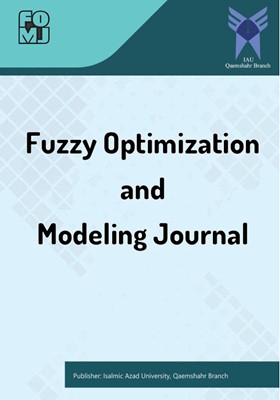Providing a Risky Investment Model in the Insurance Industry based on the Fuzzy Network Analysis Process
Subject Areas : Fuzzy Optimization and Modeling JournalYazdan Gudarzi Farahani 1 * , Hossein Abbasinejad 2 , Elnaz Hasani Parsa 3
1 - Department of Islamic Economics, Faculty of Economics and Administrative Science, Qom University, Qom, Iran
2 - Professor in Faculty of Economics, Tehran University, Tehran, Iran
3 - PhD student in Faculty of Economics, Alborz Campus of Tehran University, Tehran, Iran
Keywords: Insurance Industry, Venture Capital, Fuzzy Network Analysis Process,
Abstract :
Identifying and presenting a high-risk investment model for insurance institutions in line with the establishment of an insurance risk-taking investment fund. This research is considered to be applied in terms of purpose and field descriptive in terms of nature, and because it tries to present a model using the process of fuzzy network analysis, it is also considered as a type of modelling. In this paper, it has been tried to identify and introduce the most important factors and effective factors of venture capital (VC) using the fuzzy network analysis process technique in the insurance industry. The population of this study was insurance companies and the statistical sample includes 54 experts in the field of insurance. The required information was collected in 2023 using a standard questionnaire. Due to the lack of independence and dependence between the effective factors, the fuzzy network analysis process method was used to identify the possible dependencies between the factors and measure them for the development of the VC model, and the results were prioritized by the non-fuzzy network analysis process method. The findings of the research show that operating cycle indicators, total asset turnover ratio, total investment return, loss ratio, asset-to-debt ratio are ranked first to fifth among VC indicators. Venture capital helps the insurance industry to establish internal accounting rules and standardize their financial statements. In other words, venture capital support modifies the "hard" and "soft" information required for insurance.
1. Barkley, D., & Markley, D.M. (2001). Nontraditional sources of venture capital for rural america. Rural America, 16, 12-26.
2. Berg, H. D., & Schmidt, J. R. (1994). Foreign trade and economic growth: Time series evidence from Latin America. The Journal of International Trade & Economic Development, 3, 249-268.
3. Boer, P. (2003). Risk-adjusted valuation of R&D projects. Research TechnologyManagement, 46, 58-77.
4. Bradley, D., & Jordan, B. (2002). Partial adjustment to public. Journal of Financial and Quantitative Analysis, 4, 595-616.
5. Chen, K. S., Tsaur, R. C., & Lin, N. C. (2023) Dimensions analysis to excess investment in fuzzy portfolio model from the threshold of guaranteed return rates. Mathematics, 11, 44-67.
6. Chen, Y. S., & Zhu, C. (2009). Political connection, institutional environment and capital investment of listed companies. Journal of Financial Economic, 12, 27–39.
7. Dehghani, A., & Shahryar, B. (2017). A proposed pattern of enterprise risk management in insurance companies. Iranian Journal of Insurance Research, 7, 1-22.
8. Hall, J. & Hofer, C. (1993). Venture capitalists› decision criteria in new venture evaluation. Journal of Business, 12, 45-59.
9. Kaur, S., Singh, S., & Gupta, S. (2023). Risk analysis in decentralized finance (DeFi): a fuzzy-AHP approach. Risk Management, 25, 13-35.
10. Khataie, M. (2008). Extending financial markets and economic growth. Tehran, Iran: Monetary and Banking Research Institute Press.
11. Kollmann, T., & Kuckertz, A. (2009). valuation uncertainty of venture capitalists’ investment criteria. Journal of Business Research, 741-747.
12. Lotfizadeh, A. (1965). Fuzzy Sets. Information and Control, 8, 338-353.
13. Lukić, J., Misita, M., Milanović, D., Borota-Tišma, A., & Janković, A. (2022). Determining the risk level in client analysis by applying fuzzy logic in insurance sector. Mathematics, 18, 45-67.
14. Mazloomi, N., & Nateghi, A. A. (2020). A model of existing risks in Iran's insurance industry. Commercial Strategies, 16, 39.
15. Meade, L.M., & Sarkis, J. (1999). Analyzing organizational project alternatives for agile manufacturing processes: An analytical network approach. International Jornal of production Research, 37(2), 241-261.
16. Pietrovito F. (2012), Financial development and economic growth: A theoretical and empirical overview, Rivista di Politica Economica, 3, 232-359.
17. Saaty, T. L. (1996). Decision making with dependence and feedback: The analytic network process (Vol. 4922, No. 2). Pittsburgh: RWS publications.
18. Saaty, T.L (1980), The Analytical Hierarchy Process, New York, NY: McGraw-Hill.
19. Shahabi, R.S., Basiri, M.H., Qarahasanlou, A.N. (2022). Fuzzy MADM-based model for prioritization of investment risk in Iran’s mining projects. International Journal of Fuzzy Systems, 24, 3189–3207.
20. Sobaih, A., & Elshaer, I. (2023). Risk-taking, financial knowledge, and risky investment intention: expanding theory of planned behavior using a moderating-mediating model. Mathematics, 11, 453-487.
21. Timmons, J. A., & Bygrave, W. D. (1986). Venture capital's role in financing innovation for economic growth. Journal of Business Venturing, 2, 161-176
22. Wu, L., Xu, L. (2018). Grandstanding and new stock speculation: evidence from private venture capitals in China. Economic paper, 57, 363–375.
23. Zhang, X. (2012). Venture capital investment selection decision-making base on fuzzy theory. Physics Procedia, 25, 1369–1375.
24. Zhou, C. (2010). Dependence structure of risk factors and diversification effects. Insurance: Mathematics and Economics, 46(3), 531-540.

